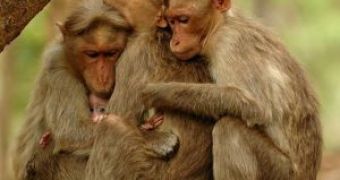It's a human behavior that varies amongst cultures: we give friends and members of the family a peck on the cheek, a quick hug, or maybe, if you are an Eskimo or Maori, even a nose rub as a sign of greeting.
Anthropologists explain that these greeting behaviors are methods employed by human individuals to assuring each other that they are not coming with hostile intentions.
These greeting behaviors have been extensively observed on chimpanzees, too, both in the wild and in captivity.
But it seems that the greeting behavior is much older than we might have thought, and recently, researchers detected that spider monkeys (Ateles geoffroyi) (photo below) also embrace intensely after a period of separation with exactly the same purpose. Spider monkeys live in groups of 15-25 individuals, but during the day, the groups break up into smaller subgroups of 2-8 individuals; for foraging and hunting (like people going to work) and then gather later during the day.
This type of social structure ('fission-fusion') is encountered in only one other primate, the chimpanzee. The size of the subgroups and the degree to which they avoid each other during the day is linked to food availability and the risk of predation.
Scientists have observed that the spider monkey reunions are often accompanied by public displays of hugging. Sometimes, the spider monkeys even curl their long prehensile Tails around one another.
But now primatologists Filippo Aureli, at Liverpool John Moores University in the U.K. and Colleen Schaffner of the University of Chester in the U.K., investigated two spider monkey groups in Mexico's Yucatan Peninsula, to see the significance of these displays. "They give a quick call and look intensely at each other, and then briefly wrap each other in their long arms in what's almost a passionate embrace," says Filippo Aureli, a primatologist at Liverpool John Moores University in the U.K.
The investigators registered 195 "fusion events" - the way the monkeys behaved when they gathered in the evenings - and found a clear pattern. The monkeys that embraced upon meeting again were more likely to display a peaceful behavior. "This is always a time of potential friction and when they're most prone to fight, because of the limited supply of food or other resources." said Aureli. Hugging is "their way of conflict management," he says. "This study shows how important greetings are in these fission-fusion societies, including our own." said Frans de Waal, a primatologist at Emory University in Atlanta, Georgia.
Photo above: Toque macaques from Sri Lanka.

 14 DAY TRIAL //
14 DAY TRIAL // 

